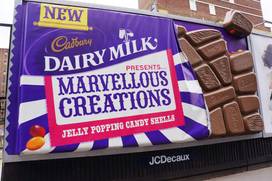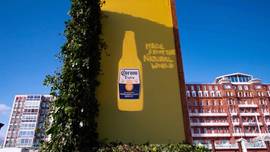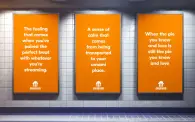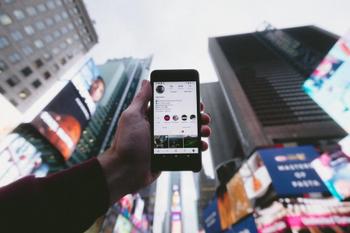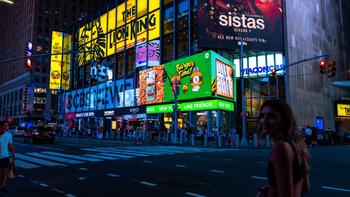While digital out-of-home (DOOH) seems to be on everyone’s mind nowadays, static OOH remains the dominant format in this space. Why is that? In a digital-dominated ad space, static OOH billboards – with their long-term exposure, eye-catching large formats, and strategic placements – can provide advertisers with a competitive edge. Unlike DOOH, where advertisers share their brand voice with other advertisers, static provides you with a 100% share of voice.
In this era of digital dominance, the power and relevance of static, or traditional, out-of-home (OOH) advertising, particularly static billboards, continue to shine through. By embracing the enduring value of static billboards and integrating them into modern advertising strategies, marketers can unlock a powerful and impactful medium that complements digital campaigns, maximizes reach, and resonates with target audiences.
The power of static billboards & traditional OOH advertising
In addition to being one of the oldest forms of advertising, with the first roadside billboards dating back to the beginning of the 19th century, static OOH remains highly utilized to this day; according to Statista, global ad spending in the traditional OOH advertising market is projected to reach USD$20.98 billion by the end of 2023 – and investment in the channel shows no signs of slowing down. It’s fair to say that, despite the prevalence of digital devices and billboards alongside online ads, static billboards continue to command attention and hold a prominent place in OOH advertising strategies.
So why do static billboards persist as a powerful and effective advertising medium in today’s digital age?
Cut through the digital clutter
One of the biggest reasons for the channel’s continued importance is its ability to captivate audiences and cut through the digital clutter, leaving a lasting impact on viewers. According to a 2022 report from the Out of Home Advertising Association of America (OAAA), over half of consumers who live in big cities notice more OOH messaging and signage today than they were pre-pandemic. And a study by Neilson revealed that 76% of American consumers notice traditional roadside billboards, and 47% notice static posters.
Influence consumer behaviour
Research has consistently shown that static billboards have a profound influence on consumer behaviour. Studies by Nielson and the OAAA reveal that 57% of American consumers notice printed advertising in venues such as retail stores, restaurants, and gas stations, and 42% report that OOH ads directly impact their in-person shopping decisions.
Target local audiences with tailored content
Static billboards also excel at reaching specific local audiences effectively. For brands looking to target a specific geographical area or community, static billboards allow for precise localization; by placing billboards strategically in the target market, marketers can effectively engage the local audience with relevant content and tailor messages to resonate with the community. They’re also an opportunity for local businesses aiming to engage with nearby consumers, offering them a cost-effective way to connect with their target audience on a more personal level and enhancing the overall effectiveness of their advertising efforts.
Digital vs static billboards: Advantages of static OOH
For those in the midst of planning an out-of-home advertising strategy, you might be wondering which will help you best achieve your campaign goals: static or digital out-of-home? The truth is that while these two forms of OOH advertising may appear similar, comparing them is akin to comparing apples and oranges. Both static and digital billboards, along with various other out-of-home media formats, have demonstrated their effectiveness in today’s diverse advertising landscape. The crucial consideration comes down to determining which type of OOH advertising best suits your particular circumstances, desired outcomes, and overall campaign goals.
To help marketers decide which to use (or how to best integrate both) for a particular campaign, we’ve broken down some of the pros and cons of each channel:
Static billboards
Advantages:
- 100% share of voice
- Always on, can never be subject to glitches or power outages
- Long-term exposure
- CPM is typically significantly lower than other formats
- Generally, less expensive production costs than digital billboards
- Increased creativity, as many billboard companies allow for designs and messaging that extend past hard dimensions
Disadvantages:
- Activation/installation can be time-consuming and costly
- Not easy to update or swap out an advertisement (and doing so will incur additional costs)
- Over time, ads may lose their novelty and impact
- Static billboards may require maintenance due to environmental changes
Digital billboards
Advantages:
- Support for multiple ad formats (video, motion graphics, dynamic HTML5 content, etc.)
- Quick, cost-effective turnaround
- Easy to make real-time updates to ad creative
- Factors such as weather, news alerts, or traffic patterns can serve as triggers to run specialized ads
- Ability to be bought and sold programmatically (pDOOH)
Disadvantages:
- Exposure time is shared amongst other advertisers
- Most ads only remain visible for 8-10 seconds
- Generally more expensive to purchase than static billboards
When to use traditional out-of-home advertising: Benefits of static billboards over DOOH
Best use cases for static OOH:
- Long-term branding campaigns
- Local targeting
- Product launches
- High-impact messaging
While digital out-of-home advertising (DOOH) has gained popularity in recent years, static billboards offer a unique set of advantages that set them apart from their digital counterparts. One key advantage lies in their unmatched visibility. With their large size and striking visuals, static billboards have the ability to capture the attention of drivers and pedestrians alike. Always-on messaging means that marketers are able to cast a wide net to achieve their brand awareness objectives, commanding the eye of anyone passing by throughout the duration of the campaign. Unlike digital billboards, where you’ll typically be sharing a screen with other advertisers, static billboards offer 100% share or voice and long-term exposure, making them an especially effective medium for reaching a wide audience.
Another advantage of static billboards is the ability to execute custom experiences featuring unique, eye-catching creatives, sometimes built for the exact real-world features of the location. Since static billboards are typically a long-term commitment requiring a vinyl or paper installation and manual setup, brands can leverage creative opportunities not available in digital, for example, by adding 3D extensions or embellishments.
Cadbury and JCDecaux UK used 3D embellishments to bring a touch of the marvellous to UK streets for the launch of Cadbury’s new Dairy Milk Marvellous Creations chocolate bar. The campaign, which featured five specially-moulded fibre-glass billboards made to look like giant 3D chocolate bars, recreated the wacky design and candy-striped packaging of the new chocolate line, providing an eye-catching prompt to consumers out and about shopping, snacking, and socializing. The takeaway: ads don’t always need to be flat. Go beyond the format’s dimensions and play with the idea of showing the product unwrapped (as in Cadbury’s case) or otherwise in use.
To drive home the message of its “100% Natural” campaign, Corona launched a foliage-adorned billboard activation at Brighton’s seafront, but in order to see it in its full glory, locals needed to catch it at the right moment. The unique OOH build came to life at golden hour, when light from the setting sun created shadows on the billboard, revealing a surprise message to passers-by. The takeaway: explore ways in which the billboard can interact with the environment to portray its key value proposition.
Static OOH can also be installed in unique, sometimes temporary, locations or in places where digital doesn’t make sense. For example, static billboards can be creatively placed on rooftops, on prominent cliffs or mountainsides, or even underwater. This opens up further creative opportunities for advertisers to mount engaging, out-of-the-box physical installations in locations that can’t accommodate digital billboards.
Static OOH advertising offers unique capabilities and creative possibilities that digital billboards can’t match. That’s not to say that one channel is better than the other, but rather that both formats have their place in the media mix. At the end of the day, static OOH is just one more tried and tested way to engage and delight the consumer.
The synergy of static OOH and digital advertising
One of the greatest things about out-of-home advertising is that you don’t have to choose between traditional OOH and DOOH or between OOH and other digital advertising. That’s because OOH, while a strong tool on its own, also plays a large role in the success of omnichannel marketing campaigns. Research from the OAAA has shown that out-of-home advertising initiatives can amplify efforts on other marketing channels by more than 90%.
By harnessing the strengths of both mediums, advertisers can achieve enhanced reach, engagement, and overall campaign effectiveness. Numerous brands have successfully utilized this strategy to achieve outstanding results. For example, as part of the multi-channel strategy for its “That Grubhub feeling” campaign with the creative agency Known, the food delivery app leveraged static billboard teasers in high-traffic areas of NYC to help build anticipation.
They then followed up their OOH campaign efforts with a mix of national video across cable, network and connected TV, as well as audio, digital radio, podcasts & SiriusXM, with additional OOH creative launching in sync with the paid local tv and radio spots airing later on. This integrated approach generated a buzz around their service offering, driving foot traffic to physical stores and online conversions.
Advertisers can also choose to integrate social media and other digital channels directly into the OOH creative by including hashtags, QR codes, website URLs, and invitations to join the conversation online. Many of the most creative OOH ads also morph into online content, extending ad campaign reach, with one in seven viewers snapping a photo and sharing it on social media. When it comes to creating a cohesive and impactful marketing campaign, the synergy of static OOH advertising and digital strategies is clearly a winning combination.
Overcoming challenges and maximizing results in static OOH
Despite the undeniable advantages of static billboards, there are a number of perceived challenges around the medium, some outdated, others simply misinformed, that are holding brands’ investment back. But recent advancements are making many of these hurdles a thing of the past. By incorporating innovative technologies, brand marketers and agencies can breathe new life into static out-of-home advertising and help maximize campaign reach and impact.
Target, track, and measure campaign impact
Measuring the effectiveness and return on investment (ROI) of static billboards has historically been seen as a challenge for marketers, especially when compared to the detailed analytics available in digital advertising. However, implementing modern tracking methods can help bridge this gap. In fact, many of the technological advancements seen in the DOOH space with respect to audience segmentation and analysis of consumer demographics, lifestyle, and behaviour are becoming more widely available to static OOH. The main difference is that data on the DOOH side can be used to trigger relevant ad content whereas the static side leverages data to strategically select locations based on the audience and owning 100% SOV.
Drive deeper engagements and cross-channel traffic
Just because a billboard is static doesn’t mean it has to be any less engaging. While traditional OOH can’t support video content or other data-based dynamic ad formats, augmented reality (AR), QR codes, and Near Field Communication (NFC) technology offer powerful tools to increase engagement and drive deeper brand interactions. By integrating these technologies into static billboards, advertisers can create interactive and memorable experiences for their audiences, bridging the gap between physical and digital realms.
Create and activate static OOH campaigns faster
Unlike with DOOH, which can be bought and sold programmatically, static media transacting still relies on manual-heavy processes. This typically means an endless stream of back-and-forth emails and phone calls with media owners, many of whom manually manage their inventory and creatives through multiple spreadsheets. But technology is also helping to simplify and streamline the turnaround for traditional OOH campaigns, with dedicated static campaign management software that offers media owners real-time inventory availability and streamlined scheduling tools to deliver and create static campaigns faster. By partnering with media owners that are equipped to handle any kind of static campaign request, marketers and agencies can ensure that their campaign gets out the door faster and is set for success.
Interested in supercharging your campaigns with static OOH?
Connect with us to learn more about getting started with the medium!

